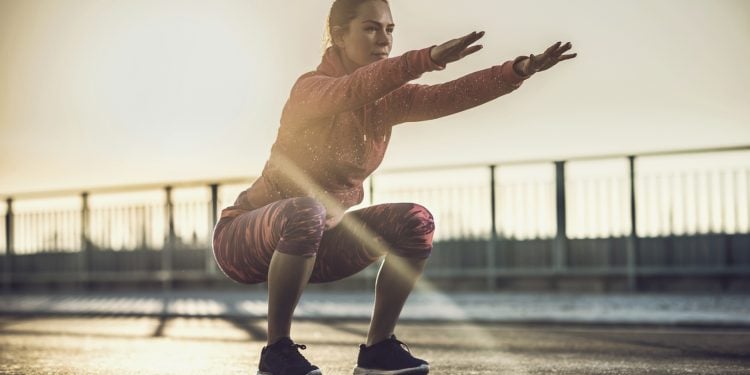Squat mechanics are very highly debated amongst fitness professionals and corrective exercise experts.
Performing an internet search of “squat form” will turn up a plethora of results including focusing most on squat depth and lifting the most weight possible to squatting with a neutral stance and favoring neutral alignment and equal joint angles above all else. The National Academy of Sports Medicine indicates that a squat should be taught to a client as follows “…the client should keep his/her feet about shoulder-width apart, toes pointing forward, back straight” (Penney et al, 2017).
However, the American Council on Exercise has a slightly different view as they recommend a client “should place the feet so that they are a little wider than shoulder-width apart.
Sit back into hips and keep the back straight and the chest up, squatting down so the hips are below the knees.” They also indicate that the toes should be pointing slightly outwards (American Council on Exercise, 2015).
These disparities can make it difficult for a trainer to make educated choices in terms of creating safe and effective programming for clients. Likewise, it is difficult to find consistent research on the topic.
Introduction
There is much debate regarding coaching to clients with their feet wide and feet externally rotated to achieve greater squat depth or in a more neutral stance to align with optimal movement mechanics.
Similarly, a great deal of importance is placed on squat depth over biomechanically sound movement mechanics, though below parallel squat patterns may be contraindicated for many clients with specific movement dysfunction patterns or knee joint pathology.
This article examines a highly debated piece of squat mechanics relating to how the foot placement (stance) ultimately affects the strain on the tibiofemoral (knee) joint.
Methods
The authors of the study examine the knee kinematics of three squat conditions. The first condition (NEU) is a neutral squat with 0 degrees of adduction/abduction with toes pointing straight ahead. The second condition is deemed a “squeeze squat” by the authors of the paper (SS).
This condition involves adducting the feet at an angle of 30 degrees. The third condition is deemed the outward squat (OS) by the researchers and involves 30 degrees of foot abduction or rather, turning the feet outward.
The researchers selected 15 healthy college students (9 females, 6 male) who were matched for age, height, and weight (means were 21.4 years, 170 cm and 64.7 kg respectively). Subjects who had any history of injury or balance problems were excluded from the study.
Each of the subjects were asked to perform 6 trials in each of the conditions (NEU, SS, OS) and the mean values for the trials was reported. The subjects were instructed to maintain a neutral squat distance (feet shoulder width apart) and arms extended completely with 90 degrees of flexion at the glenohumeral joint and squat until the crest of the buttocks was level with the knee (parallel).
The researches fitted each of the subjects with a tracking system to collect kinematic data. These trackers were attached to the outside of the each of the feet, shanks, thighs and two locations on the pelvis. A coordinate system was created to measure kinematic data.
Data/Results
The peak angles of flexion were relatively similar between all the three conditions and did not reach the level of statistical significance. However, the authors did discover that during the OS condition, as knee flexion increased, the knee had the tendency to internally rotate.
In contrast, the opposite occurred in the SS condition with the knee having the tendency towards external rotation as knee flexion increased. At maximum knee flexion, the neutral squat produced 1.1±5.60 degrees of internal rotation as compared to the SS condition which produced 1.9±6.06 degrees and the OS condition producing 3.9±5.46 degrees of internal rotation.
Likewise, at maximum knee flexion, the neutral squat produced 1.0±7.26 degrees of external rotation as compared to the SS condition which produced 3.6±8.38 degrees and the OS condition producing 2.3±3.57 degrees of external rotation.
Peak abduction and adduction moments were highly influenced by the foot position. Maximum adduction was 0.5±0.59 for the NEU condition as compared to 0.1±0.43 in the SS condition and 0.9±0.43 degrees in the OS condition. Likewise, maximum abduction at peak knee flexion was 1.2±0.65 degrees in the NEU condition, 1.9±0.10 degrees in the SS condition and 0.6±0.40 degrees in the OS condition.
However, the authors determined that the compressive force and shear force on the tibiofemoral joint were similar in all three squat conditions.
Discussion
The results of the study demonstrate that the shear and compressive forces are the same in all three squat conditions at peak knee flexion, however, the tendency towards internal and external rotation of the knee at maximum flexion is problematic as was the case in the SS and OS conditions.
The relatively extreme internal and external rotation of the knee in these conditions could compress the meniscus and potentially other structures in the knee causing harm (Lorenzetti et al, 2018).
Additionally, the authors indicate that increases adduction and abduction moments will also put strain in the medial (in the case of adduction) and lateral (in the case of abduction) compartments which could potential lead to injury in addition to the eventual development of osteoarthritis.
This notion is supported by Marriot et al. (2017) when they examined the effect of peak knee adduction in relation to walking gait where OA pain was significantly increased at higher peak knee adduction moments (Marriot et al, 2017).
Overall, the authors indicate that the SS and OS conditions, with foot adduction/abduction, will lead to improper weight distribution on various compartments of the knee even though the maximum forces are similar.
The researchers strongly recommend that clients and patients are trained to squat in the NEU condition with toes and feet in a forward position.
The authors of the study also comment that with increasing knee flexion, the compressive and shear forces do increase as previous research has supported and thereby recommend that clients/patients with any history of knee pathology should avoid high knee flexion squats and decrease their overall range of motion during a squats (Han et al., 2013).
Limitations of Study
There are a few limitations attributed to this study. First, the muscle activity was not at all measured in this study, only joint angles and force measurements were taken. Second, the group was a mix of males and females. Females tend to have an increased knee valgus and generally more laxity in the supporting structures in the knee which could confound the results (Boguszewski et al, 2015).
Applications/Questions for further study
This study proposes that a neutral squat condition with toes pointing forward is the safest way to squat for the knee joint.
The authors indicate that based on their findings, internal/external rotation of the knee as well as extremes in adduction/abduction at peak knee flexion can place strain on various support structures in the knee thereby predisposing a client to injury and/or the development or worsening of osteoarthritis.
Additional studies support neutral stance width and foot placement being the safest position for both the knees and the lumbar spine (Lorenzetti et al, 2018).
Many powerlifters and Olympic lifters will often perform wide squats with feet turned out like the OS condition in this study. In the case of Olympic lifting and powerlifting, squat depth is important and the recruitment of other available musculature (i.e., heavy reliance on the adductors) is necessary to lift higher weight loads (Swinton et al, 2012).
However, this is not appropriate for the general population. It is also important to point out that powerlifting and Olympic lifting are sports, and sports oftentimes come with a risk of injury (Miller, 2019).
The goal of a personal trainer is not necessarily to serve as a coach for sports (unless specifically hired to do so), but rather, to assess and correct faulty movement patterns as well as to reinforce biomechanically sound movement patterns to prevent injuries.
According to Han et al. (2017), the most biomechanically sound squat pattern to teach and reinforce is a neutral stance (toes pointing forward), with feet shoulder width apart and maintaining proper alignment and peak flexion over squat depth (Han et al., 2017).
It is critical to assess the client’s movement patterns via the OHSA (overhead squat assessment) to determine whether their squat mechanics are optimal. For instance, the excessive forward lean pattern may indicate poor dorsiflexion at the ankle or poor hip mobility.
A foot turnout may suggest an overactive lateral gastrocnemius/soleus, biceps femoris, or tensor fascia latae coupled with underactivity in the medial gastrocnemius, gluteus medius/maximus, and medial hamstrings. These compensations may also be associated with other pathologies such as Patellar tendonitis, Achilles tendonitis, and Plantar fasciitis (Clark et al., 2014).
It is not advisable to have a client simply turn their feet out to achieve lower squat depth in these cases as it reinforces already present movement compensations. Likewise, a client with pre-existing knee pathology should be monitored closely and should avoid high flexion angles in the knee joint.
Corrective exercise can be quite beneficial for these clients. The fitness professional should apply proper corrective exercise techniques to correct any imbalances prior to loading the client with significant resistance when coaching squats. Always bear in mind that the primary role of a certified personal trainer is to teach and reinforce biomechanically sound movement patterns.
Read Squat Biomechanics for more information on the breakdown of the squat.
References
American Council on Exercise. (2019). Exercise Library: Bodyweight Squat.Www.Acefitness.Org. https://www.acefitness.org/education-and- resources/lifestyle/exercise-library/135/bodyweight-squat
Boguszewski, D. V., Cheung, E. C., Joshi, N. B., Markolf, K. L., & McAllister, D. R. (2015). Male-female differences in knee laxity and stiffness. The American Journal of Sports Medicine, 43(12), 2982–2987. https://doi.org/10.1177/0363546515608478
Clark, M. A., Lucett, S. C., & Sutton, B. (2014). NASM essentials of personal fitness training. Burlington Jones & Bartlett Learning.
Han, S., Ge, S., Liu, H., & Liu, R. (2013). Alterations in three-dimensional knee kinematics and kinetics during neutral, squeeze and outward squat. Journal of Human Kinetics, 39(1), 59–66. https://doi.org/10.2478/hukin-2013-0068
Lorenzetti, S., Ostermann, M., Zeidler, F., Zimmer, P., Jentsch, L., List, R., Taylor, W. R., & Schellenberg, F. (2020). Correction to: How to squat? Effects of various stance widths, foot placement angles and level of experience on knee, hip and trunk motion and loading. BMC Sports Science, Medicine and Rehabilitation, 12(1). https://doi.org/10.1186/s13102-020-0160-6
Marriott, K. A., Birmingham, T., Moyer, R., Kanko, L., Pinto, R., Primeau, C., & Giffin, R. (2017). Association between high external knee adduction moment and increased pain during walking: within-limb comparisons in patients with medial compartment knee osteoarthritis. Osteoarthritis and Cartilage, 25, S112. https://doi.org/10.1016/j.joca.2017.02.180
Miller, M. (2019). Performance Enhancement for the Average Joe. NASM Optima 2019.
Penny, S., Stone, J., & Comana, F. (2017, June). Six squat exercise variations that bring great results. Blog.Nasm.Org. https://blog.nasm.org/the-training-edge/six-squat-exercise- variations-bring-great-results/.
Swinton, P. A., Lloyd, R., Keogh, J. W. L., Agouris, I., & Stewart, A. D. (2012). A Biomechanical comparison of the traditional squat, powerlifting squat, and box squat. Journal of Strength and Conditioning Research, 26(7), 1805–1816. https://doi.org/10.1519/jsc.0b013e3182577067












